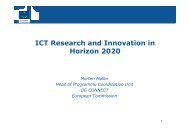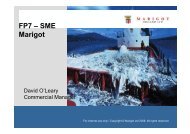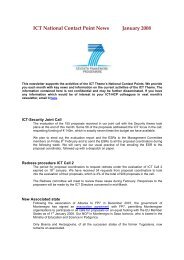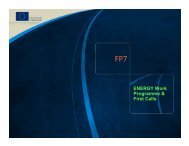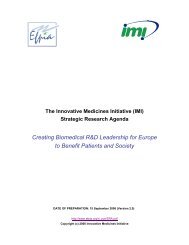Research for a Secure Europe - European Commission - Europa
Research for a Secure Europe - European Commission - Europa
Research for a Secure Europe - European Commission - Europa
Create successful ePaper yourself
Turn your PDF publications into a flip-book with our unique Google optimized e-Paper software.
<strong>Research</strong> <strong>for</strong> a <strong>Secure</strong> <strong>Europe</strong><br />
B. <strong>Research</strong> & Technology – ‘<strong>for</strong>ce<br />
enablers’ <strong>for</strong> a secure <strong>Europe</strong><br />
Technology itself<br />
cannot guarantee<br />
security, but<br />
security without<br />
the support of<br />
technology is<br />
impossible.<br />
■ 4. New technological opportunities<br />
Technology itself cannot guarantee security, but security without the support<br />
of technology is impossible. It provides us with in<strong>for</strong>mation about threats, helps<br />
us to build effective protection against them and, if necessary, enables us to<br />
neutralize them. In other words: technology is a key ‘<strong>for</strong>ce enabler’ <strong>for</strong> a more<br />
secure <strong>Europe</strong>.<br />
At the same time, the security dimension of technology itself is changing,<br />
because technology is very often multi-purpose. Civil and defence applications<br />
increasingly draw from the same technological base and there is a growing crossfertilization<br />
between the two areas.<br />
Technologies initiated <strong>for</strong> defence purposes have already led to important<br />
commercial applications. The Internet and the Global Positioning System<br />
(GPS) are the most prominent examples of such dual-use technologies. However,<br />
‘spill-over’ effects increasingly work both ways: the so-called ‘Revolution in<br />
Military Affairs’, in particular, is based on a combination of electronics,<br />
in<strong>for</strong>mation technology and telecommunications. To a large extent, these<br />
technologies have not been developed by defence companies but by civilian<br />
firms <strong>for</strong> the commercial market. In the key area of ‘network-enabled capability’,<br />
there is a distinct technology flow from the civil to the defence sector.<br />
Civil and defence<br />
applications<br />
increasingly draw<br />
from the same<br />
technology base.<br />
As a result, the technology base <strong>for</strong> defence, security and civil applications<br />
increasingly <strong>for</strong>ms a continuum. Across this continuum, applications in one area<br />
can often be trans<strong>for</strong>med into applications in another area. This is particularly the<br />
case <strong>for</strong> defence and security: while the armed <strong>for</strong>ces and the various security<br />
services will always have their specific needs, there is an increasing overlap of<br />
functions and capabilities required <strong>for</strong> military and non-military security purposes<br />
(such as is found between border police, coast guard and emergency response<br />
teams) that often allows the use of the same technology <strong>for</strong> the development of both<br />
security and defence applications. Space technologies are a perfect illustration of<br />
this: a decision as to whether global positioning or earth observation systems, <strong>for</strong><br />
example, are to be used <strong>for</strong> defence and security purposes is primarily political in<br />
character, not technological. Biotechnology provides another example: The same<br />
tools which can detect and fight harmful biological aspects with high sensitivity<br />
can be used to protect the population from bio-terrorist attack and from natural<br />
epidemic outbreaks.<br />
12




